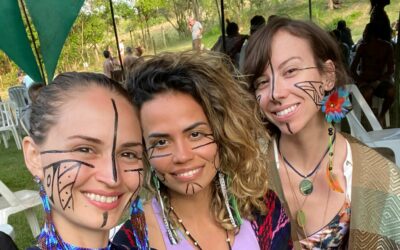When you hear the words “masculine” or “feminine” what comes to mind?
Likely a specific type of man or particular type of woman, but archetypes of both masculine and feminine energies live within us all, and the spectrum they each span is broader than you might think.
Speaking with Angell Deer, Shamanic Practitioner of The Sanctuary in Callicoon, he shared in very basic terms, that the masculine energy archetype is one of an outward process—or more active doing, like the mind or speaking—and the feminine energy archetype is one of a more internal process—being, listening, holding, and creating from within; receptive, but not entirely passive, stillness, but with movement in flow, the heart.
Deer works closely with indigenous peoples, and his teachers / tribe elders look to nature as a guide—in this case, more specifically at nature’s inclination towards balance. As such, you have day and night, summer and winter, and can find elements like air and fire that are more masculine in their activity, give balance to the more feminine elements of Earth and water that are nourishing and give / sustain life. Even the human body, as an individual representation of the Earth, is a feminine archetype. So, too, is the emotional space, whereas the mind / mental space is more masculine, for example.
But you also see where there is less black and white duality.
Deer offered these examples: take a flower, which has both masculine and feminine parts for reproduction, or how bees are born with the ability to develop either genitalia and what they are fed within the first three days is the determining factor. This understanding that nature exists in the gray space of balance, can potentially help one begin to acknowledge their own imbalances, regardless of gender identification, and show the reality of holding space for potentially contradictory information to exist simultaneously.
Even Quinn Alexander Fontaine—artist, inspirational comic, #1 international best selling author of the book Hung Like a Seahorse, and proud transgender man—shared how he needs both or would otherwise be way out of balance.
“My masculine energy helps me move forward in life and my feminine energy reminds me to do it mindfully and with more self care. My inner masculine helps me stay motivated and get “unstuck” and my inner feminine is the nurturing aspect that really lovingly helps me re-parent my inner child. I feel that it’s my inner feminine that helps me forgive myself frequently,” he says.
It has become increasingly clear that as a society, we are imbalanced in the direction of the masculine—war, greed, over-consumption, our obsession with productivity and power, praise of the mind space over the feeling space—which means to move back into balance, we must sway in the direction of putting connection to our inner feminine in top priority. With March being Women’s History Month and the host of International Women’s Day (which is March 8), there’s no better time to begin to acknowledge this in our own lives. But what does that actually look like?
First, let’s take a look at both energy archetypes in the human form.
A wounded masculine—or one that is out of balance—might show up as aggressive, defensive, controlling, competitive, stuck in the mind / out of touch with the body or feelings, cold, distant / withdrawn, greedy, addiction, even war is an example of out of balance masculine. On the flip side, a healthy masculine archetype can present as assertive, responsible, accountable, with boundaries and structure, safety and stability, presence.
For the wounded or out of balance feminine, this might show up as jealousy, insecurity, low self worth, codependency, indecisiveness, manipulative tendencies, being over-emotional, inauthentic, afraid to speak up, whereas the healthy feminine is more grounded, surrendered, nurturing, open, vulnerable, receptive, magnetic, flexible, tender, in flow.
Deer shared that when the inner feminine doesn’t feel safe, the inner masculine will do what it can to protect. And if we hold a lot of pain and trauma, it will protect in a wounded way. So the key to more balance and harmony both internally and externally is giving attention to the feminine wound and where it comes from: family upbringing, ancestral traumas, genocide, war, socio-economic systemic imbalances.
“So very often the experience we have of safety in the world around us is our experience of safety in us, with our own body, with our own emotions,” Deer says.
This could come from real time threats, but for many comes from cellular memory of unhealed pain and trauma.
My restorative yoga teacher, Jillian Pransky, says “In order to relax, we need to first feel safe.” That struck a chord with me as I assessed my life-long inability to slow down and sit still. I realized the anxiety, tension, and need to constantly be doing something stemmed from having grown up in a very loud, dysfunctional household. My inner feminine didn’t feel safe, so my inner masculine took over and kept me busy (and angry) so I wasn’t totally overwhelmed by the amount of grief I actually felt.
I’ll invite you to notice your own aversion to stillness and silence—feminine qualities—and ultimately really being in your body. It shows up in myriad ways: binge watching Netflix on a daily basis, working too much, eating too much food and sweets, drinking alcohol or doing drugs, gossiping and talking a lot are all examples of noise to drown out this really important connection. However, Deer offers the first good step is just to be aware of what we do to avoid listening and just this awareness is enough to open an inner dialogue sometimes.
Once you’re able to approach your wounding and imbalances with compassionate curiosity, you can begin to practice deep listening, or bearing witness. Deer explained this as a space where the mind stops; there is no preparation of an answer, no judgment, no action, just a surrender and a trust in yourself, in the person you’re practicing deep listening and bearing witness with, even a faith in something greater. My personal experience of this type of genuine presence is a spaciousness that extends time. And in that spaciousness, needs and options present themselves with clarity because I am able to trust in the present moment holding infinite possibilities.
For Fontaine, the daily morning practice of meditation and prayer are sacred moments that not only connect him to his inner feminine, but also where he feels connected to creation, and all that is kinder, gentler and softer in the world. On occasions where he feels stressed or overwhelmed, he also practices Earthing—walking barefoot on the earth—and asks Mother Earth to take all he cannot hold in his body temple.
The act of deep listening, the stillness of meditation, connection to the Earth, and deep surrendering, are all divinely feminine in nature.
For me, softening my mascuilne protective layer and reconnecting to my feminine has taken evolutionary shape over years of conscious effort. It began physically, as a shift to wear more flowy clothing. The softness and flow of the garments, scarves, and shawls reminded me to soften my body and go with the flow of what presented itself to me rather than trying to control every detail. As I continued down the path, I realized the linear nature of performing as a Rockette at Radio City Music Hall was a reflection of my masculine, and that leaning into embodied movement—exploring my body and space in ways that felt good and expansive and in the moment—was dancing in my feminine. My power yoga practice and way of teaching was also a reflection of my over-powered masculine, so learning restorative yoga helped me practice putting my trust in the props to be there for me, and then for me to be there for me.
Connecting with and honoring the inner feminine that resides in us all will look a little different for everyone, but in doing so, we open the space to connect with others from a place of deeper empathy.
Fontaine says when connecting to someone inner feminine to inner feminine, deeper trust forms.
Deer explains, “If I can practice deep listening with myself, really return to my body, and practice deep listening with others, I can expand my wisdom and my capacity to be present maybe with things that I can’t comprehend, don’t agree with, or can’t change.” That when we expand our capacity to live in the paradoxes of life, we also expand our capacity to connect with others. He says if we really listen to another, to ourselves, to the wisdom of our bodies and nature, then we might discover something deeper that is moving inside us because as human beings we’re designed to belong with each other, to be safe, to be loved, to receive love, to know that we are worthy of it.
Finding balance between our inner masculine and inner feminine energy archetypes, taking time to slow down, listen, and receive the wisdom our bodies, the Earth, and others are yearning to share with us, might feel like a tall order. But no matter how you identify, when we connect with and honor our inner feminine, it reflects in positive health across all aspects of our lives.
Photo Credit: Colton Sturgeon



